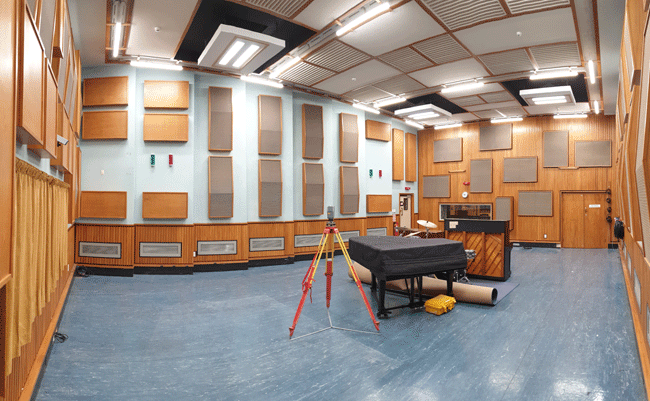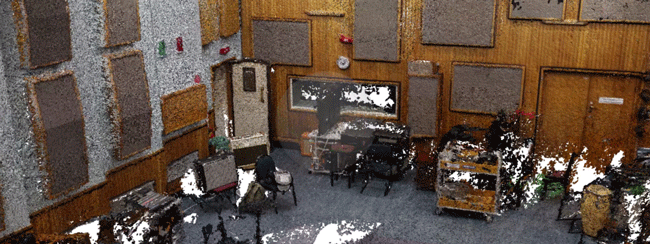
A panoramic photograph of the University's soon-to-be demolished Albany St studio, which will form the basis of a virtual replica being constructed by Otago staff.
A collaborative project is aiming to digitally preserve the University's Albany St recording studio so music can continue to be created there – only in virtual reality.
If it gets funding, the project will allow musicians in the future to enter an exact virtual replica of the space.
Not only that, but their recordings will have the studio's unique acoustic characteristics. In other words, the finished works should sound just like they were created in the physical studio.
The first stage of the project is already under way because the asbestos-affected Albany St music building is scheduled to be demolished in early 2020.
So before it disappears, the studio, which dates from 1967 and is modelled on a BBC design, is being precisely mapped so it can be recreated in virtual reality.
The work has brought together a passionate group of people from the Music Department, Information Science, Computer Science and the School of Surveying.
Supervising is Information Science Head of Department Professor Holger Regenbrecht, who specialises in virtual and augmented reality.
“The main idea is to preserve what's there because that studio is amazing. I always loved it and it's a mythical place.”
The ultimate scope of the work is no small task, which is why it is being undertaken in two phases.
The first stage involves surveying a 3D profile of the room to build a framework to hold the thousands of images needed to capture the space visually. At the same time, sophisticated acoustic recordings are being captured from every part of the studio.
“We can go, 'Oh I wonder what this would sound like if I was playing it in the Albany St room and then lay the Albany St reverb on.' When you're in virtual reality, the audio is as important as the visual,” explains senior music lecturer Dr John Egenes.
Dr Egenes is part of a team including Professor Regenbrecht, Steven Mills (Computer Science), Mike Holland and Stephen Stedman (Music), Mike Denham (School of Surveying) and hard-working students Finn Petrie (Computer Science) and Noel Park (Information Science).
Watching them in action, gathered around the blinking lights of the laser scanner, it is clear Mr Denham isn't overstating things when he describes it as “an amazing collaboration”.

A first, rough three-dimensional (“point cloud”) reconstruction of the Albany St Studio based on photographs taken on site.
The capture work is almost complete but stage 2 – building the virtual model – is much more complex and will require time and funding to complete. A best-case scenario is completing the first virtual reality studio by the end of 2020.
“What we want is a dynamic environment so you can walk through it and the environment sounds different depending on where you are. Once we have that we want to put musicians into that room virtually,” Professor Regenbrecht says.
“We might offer Albany St as a virtual place you can come to even if you're in Sydney or New York. There's plenty of potential if we get enough resources to get it finished.”
In another related side project Professor Regenbrecht has worked with Dr Egenes to capture Dunedin folk musicians Anna Bowen and Mike Moroney using a technology called volumetric pixels, also known as voxels.
“They played an Irish folk song and John recorded them acoustically in the Albany St studio and we recorded them in our lab downstairs in 3D visually. We put that together and synchronised it and now we have that clip where you have two musicians playing and you can walk around them.
“I call it voxelvideos—the next generation of YouTube video clips. They are not 2D. You can walk into the clips.
“That will link also to this project because hopefully we can put Mike and Anna into the new reconstructed studio virtually.”
The Albany St studio is being replaced with a state-of-the-art recording studio in the University's new $26 million music, theatre and performing arts facility.
One day, all going well, musicians recording in the University's new studio will have the option of taking a trip to the past by locating themselves virtually in Albany St.
“This is an historical room and it's worth saving,” says Dr Egenes of the Albany St studio. “It's a very special space.”